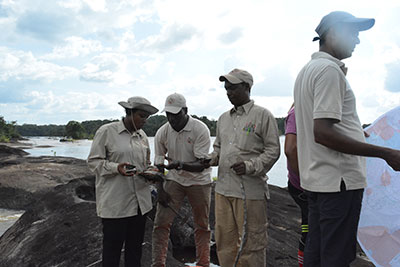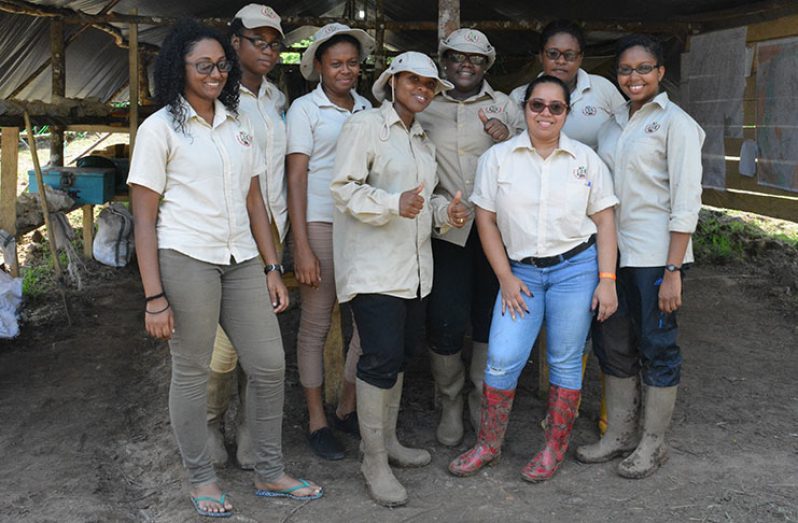–in the male-dominated field of geo-chemistry
WHEN Unatha Defreitas started working at the Guyana Geology and Mines Commission (GGMC) more than 19 years ago, she was among the few female geo-technicians and geologists in the country.

Back then, ‘Geology and Mines’ was dominated by men. Today, the tide is swiftly changing, with more and more women gravitating to the field of geology.
“I have been in it for some 19 years, and I would have met a lot of geologists but definitely we have had an increase in the number of women entering the field,” the Senior Geologist attached to GGMC’s Geological Services Division said as she sat underneath a makeshift tent at the commission’s base camp, approximately 20 miles from Itaballi in the Cuyuni/Mazaruni District.
Working in the field of geology is undoubtedly a challenge, she said, but one that can be overcome. While female geo-technicians and geologists have been doing an “excellent” job with the strong backing of their male colleagues at the Geo-Services Division, Defreitas believes that in some instances, their work is underplayed because some persons do not understand the profession.
DATA COLLECTION
“Our job, basically, is to collect the country’s mineral information. Now, we do that from the baseline, so when we start our stream sediment sampling, we are actually gathering information on the elemental composition of the areas that we sample,” she said.
“From that information we get an idea…of the types of minerals existing in the area and the types of rocks they would have broken down from,” she explained.
Travelling throughout the length and breadth of the country, the team of geologists and geo-technicians attached to the Geo-Services Division not only collect stream sediment samples to determine the country’s mineral potential, but they also map the areas of study.
“We have a passion for the natural patrimony, and we understand that the more information we get, the better position our country will be in,” the veteran geologist said.
In the Cuyuni/Mazaruni district, Defreitas is part of a dynamic team of geologists and geo-technicians wrapping up the Mazaralli Regional Geo-chemical Exploration Project, which is valued at $40M, and entails the collection of 410 sediment and the simultaneous mapping of the area.
PART OF A TEAM
But she’s not the only woman on the team, as she’s accompanied by four others; two geologists and two geo-technicians.
Twenty-one-year-old Nkechi McPherson, who this year became the University of Guyana’s Faculty of Technology’s youngest best graduating student, is a part of the dynamic team working on the geo-chemical project.
Just after completing high school, McPherson, in 2011, began a two-year programme at the university, reading for her diploma in Geological Engineering. At the time she was on a GGMC scholarship, and so the programme was paid for by that agency.
Now that she has a degree in the subject area, she’s offering her knowledge and skills to the work of the commission. “I am here permanently to serve back, and the experience has been good, but it is a lot of hard work, so you should be active before you get into the field,” she told the Guyana Chronicle during a recent visit to the project site.
For the first time, McPherson is leading a sub-unit of the team to areas where samples are required to be taken in the project area covering approximately 1,800 square kilometres between the Cuyuni and Mazaruni Rivers, with Itaballi and Takutu to the east and west, and Piari and Oku to the north and south.
“Not only do we do geo-chemical sampling, but we also do geological mapping; that has been new to me, so I have been learning and gaining more experience,” she said.
Offering her advice to upcoming geologists, McPherson said:
“You have to understand that not everything you see on the map will be on the ground; you have to cater for all of those uncertainties.”
A REWARDING EXPERIENCE
For Tricia Tulluck, it is the first time she is in “the fields”, away from the hustle and bustle of the city, but the experience has been rewarding.
“So far, it has been quite interesting,” she said. “I like it a lot; I didn’t expect to like it this much, but it is good; you get to learn different things, and you get to learn so much more about your country.”
Tiace Fraser, who has been with the commission since 2009, says though the field work can be challenging at times, the older women in the field are often her inspiration to push ahead.
“It is a very interesting job,” said 26-year-old Marissa Foster. “It entails a lot of field work, going into the fields collecting sediment samples, doing some geological mapping, and offering technical assistance to miners.”
She was just 22 when she joined the GGMC as a geologist. “It is very empowering to break out from the norm, and to be an inspiration for other young women,” she told this newspaper, while disclosing her intention to pursue Petroleum Geo-science in the future.
LIVING TESTIMONY
Minister within the Ministry of Natural Resources, Simona Broomes, who has a wealth of experience in the field of mining, said that the female geologists and geo-technicians are living testimonies, like herself.
“People say, ‘Oh! She’s a miner; she’s a pork-knocker!’ But look at me now! I’m a minister; the sky is the limit!” she said, adding:
“I would want to encourage women to get involved; we are tidier; we can make a difference in these areas.”
Minister Broomes said women should be applauded for taking up the mantle. “I think it is a wonderful thing; it tells you the sky is the limit and I would want to tell women to get involved,” she posited.
More women, she emphasised, should take up greater professions in the field of geology and by extension in the extractive industry.




.jpg)










